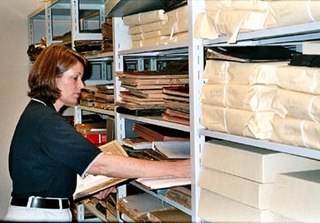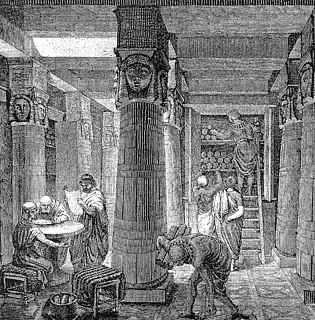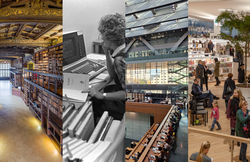Archives New Zealand is New Zealand's national archive and the official guardian of its public archives. As the government's recordkeeping authority, it administers the Public Records Act 2005 and promotes good information management throughout government.

A librarian is a person who works professionally in a library providing access to information, and sometimes social or technical programming, or instruction on information literacy to users.

An archive is an accumulation of historical records or materials – in any medium – or the physical facility in which they are located.

Digitization is the process of converting information into a digital format. The result is the representation of an object, image, sound, document or signal obtained by generating a series of numbers that describe a discrete set of points or samples. The result is called digital representation or, more specifically, a digital image, for the object, and digital form, for the signal. In modern practice, the digitized data is in the form of binary numbers, which facilitates processing by digital computers and other operations, but, digitizing simply means the conversion of analog source material into a numerical format; the decimal or any other number system can be used instead.

An archivist is an information professional who assesses, collects, organizes, preserves, maintains control over, and provides access to records and archives determined to have long-term value. The records maintained by an archivist can consist of a variety of forms, including letters, diaries, logs, other personal documents, government documents, sound and/or picture recordings, digital files, or other physical objects.

Library and Archives Canada is the federal institution, tasked with acquiring, preserving, and providing accessibility to the documentary heritage of Canada. It is the fifth largest library in the world.
Records management, also known as records and information management, is an organizational function devoted to the management of information in an organization throughout its life cycle, from the time of creation or receipt to its eventual disposition. This includes identifying, classifying, storing, securing, retrieving, tracking and destroying or permanently preserving records. The ISO 15489-1: 2001 standard defines records management as "[the] field of management responsible for the efficient and systematic control of the creation, receipt, maintenance, use and disposition of records, including the processes for capturing and maintaining evidence of and information about business activities and transactions in the form of records".
In library and archival science, digital preservation is a formal endeavor to ensure that digital information of continuing value remains accessible and usable. It involves planning, resource allocation, and application of preservation methods and technologies, and it combines policies, strategies and actions to ensure access to reformatted and "born-digital" content, regardless of the challenges of media failure and technological change. The goal of digital preservation is the accurate rendering of authenticated content over time. The Association for Library Collections and Technical Services Preservation and Reformatting Section of the American Library Association, defined digital preservation as combination of "policies, strategies and actions that ensure access to digital content over time." According to the Harrod's Librarian Glossary, digital preservation is the method of keeping digital material alive so that they remain usable as technological advances render original hardware and software specification obsolete.
Archival science, or archival studies, is the study and theory of building and curating archives, which are collections of documents, recordings and data storage devices.
The following outline is provided as an overview of and topical guide to library science:
A finding aid, in the context of archival science, is an organization tool, a document containing detailed, indexed, and processed metadata and other information about a specific collection of records within an archive. Finding aids often consist of a documentary inventory and description of the materials, their source, and their structure. The finding aid for a fond is usually compiled by the collection's entity of origin, provenance, or by an archivist during archival processing, and may be considered the archival science equivalent of a library catalog or a museum collection catalog. The finding aid serves the purpose of locating specific information within the collection. The finding aid can also help the archival repository manage their materials and resources. The history of finding aids mirrors the history of information. Ancient Sumerians had their own systems of indexes to locate bureaucratic and administrative records. Finding aids in the 19th and 20th centuries were paper documents, such as lists or index cards. In the 21st century, they can be created in electronic formats like spreadsheets or databases. The standard machine-readable format for manuscript collection finding aids, widely used in the United States, Canada, the United Kingdom, France, Australia and elsewhere, is Encoded Archival Description.
Web archiving is the process of collecting portions of the World Wide Web to ensure the information is preserved in an archive for future researchers, historians, and the public. Web archivists typically employ web crawlers for automated capture due to the massive size and amount of information on the Web. The largest web archiving organization based on a bulk crawling approach is the Wayback Machine, which strives to maintain an archive of the entire Web.
Archival processing is the act of surveying, arranging, describing, and performing basic preservation activities on the recorded material of an individual, family, or organization after they are permanently transferred to an archive. A person engaging in this activity is known as an archival processor, archival technician, or archivist.

In library and archival science, preservation is a set of preventive conservation activities aimed at prolonging the life of a record, book, or object while making as few changes as possible. Preservation activities vary widely and may include monitoring the condition of items, maintaining the temperature and humidity in collection storage areas, writing a plan in case of emergencies, digitizing items, writing relevant metadata, and increasing accessibility. Preservation, in this definition, is practiced in a library or an archive by a librarian, archivist, or other professional when they perceive a record is in need of maintenance.

Library science is an interdisciplinary or multidisciplinary field that applies the practices, perspectives, and tools of management, information technology, education, and other areas to libraries; the collection, organization, preservation, and dissemination of information resources; and the political economy of information. Martin Schrettinger, a Bavarian librarian, coined the discipline within his work (1808–1828) Versuch eines vollständigen Lehrbuchs der Bibliothek-Wissenschaft oder Anleitung zur vollkommenen Geschäftsführung eines Bibliothekars. Rather than classifying information based on nature-oriented elements, as was previously done in his Bavarian library, Schrettinger organized books in alphabetical order. The first American school for library science was founded by Melvil Dewey at Columbia University in 1887.
A digital library, also called an online library, an internet library, a digital repository, or a digital collection is an online database of digital objects that can include text, still images, audio, video, digital documents, or other digital media formats or a library accessible through the internet. Objects can consist of digitized content like print or photographs, as well as originally produced digital content like word processor files or social media posts. In addition to storing content, digital libraries provide means for organizing, searching, and retrieving the content contained in the collection. Digital libraries can vary immensely in size and scope, and can be maintained by individuals or organizations. The digital content may be stored locally, or accessed remotely via computer networks. These information retrieval systems are able to exchange information with each other through interoperability and sustainability.

The Jean-Nickolaus Tretter Collection in Gay, Lesbian, Bisexual and Transgender Studies is a collection of LGBT historical materials housed in the Special Collections and Rare Books section of the University of Minnesota Libraries. It is located underground in the Elmer L. Andersen special collections facilities on the University of Minnesota's Minneapolis campus. The Tretter Collection houses over 40,000 items, making it the largest LGBT archive in the Upper Midwest and one of the largest GLBT history collections in the United States. The collection is international in scope and is varied in media.
The Queensland State Archives is the lead agency for public recordkeeping in Queensland, Australia. It is the custodian of the largest and most significant documentary heritage collection about Queensland.

GLAM is an acronym for "galleries, libraries, archives, and museums", and refers to cultural institutions with a mission to provide access to knowledge. GLAMs collect and maintain cultural heritage materials in the public interest. As collecting institutions, GLAMs preserve and make accessible primary sources valuable for researchers. The term, in particular in related forms such as LAM is increasingly used for the comparative studies of these institutions, often motivated by their claimed convergence.

Archival research is a type of research which involves seeking out and extracting evidence from archival records. These records may be held either in collecting institutions, such as libraries and museums, or in the custody of the organization that originally generated or accumulated them, or in that of a successor body. Archival research can be contrasted with (1) secondary research, which involves identifying and consulting secondary sources relating to the topic of enquiry; and (2) with other types of primary research and empirical investigation such as fieldwork and experiment.











